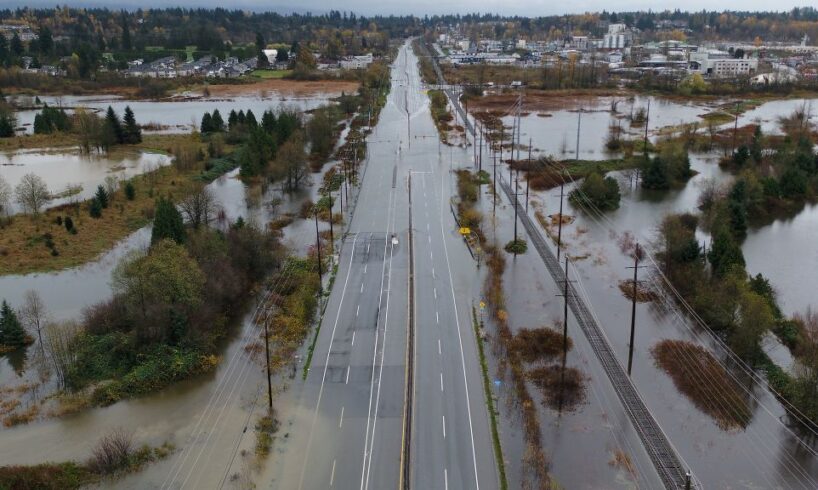
This story is part of Habitat, a series from The Narwhal which looks at how communities are working to address the housing and climate change crises simultaneously
Extreme weather — from wind storms to intense heat to flooding — is nothing new for B.C. But climate change is making catastrophic weather events more severe and more frequent.
Nearly one-quarter of households in the province experienced extreme weather in 2023, the most recent year for which Statistics Canada has data available. The Insurance Bureau of Canada ranked 2023 as the fourth most expensive year on record for insurance claims related to severe weather, including $720 million for damage done by wildfires in the Okanagan and Shuswap.
In 2023, wildfires ripped through B.C.’s Okanagan and Shuswap regions, leaving $720 million in damages in their wake. Photo: Mike Graeme / The Narwhal
Then 2024 “shattered” records for the most expensive year for catastrophic weather damage, surpassing $8 billion for the first time.
Since 2017, B.C.’s Ministry of Emergency Management and Climate Readiness has doled out about $550 million for thousands of disaster-preparedness and mitigation projects organized by local governments and First Nations. As climate change accelerates and housing demand soars, B.C. is facing a critical moment: where and how we build homes could either protect people and ecosystems — or leave them increasingly vulnerable. How do we make these decisions and when is it time to decide to retreat rather than rebuild?
Better data can help us make better decisions about housing and climate risks, researcher says
It’s hard to make good decisions without good information. And when it comes to wicked problems, such as B.C.’s housing crisis, decision-makers need a lot of good information: where housing is needed, what it will cost, impacts on the environment and more.
Because building housing isn’t just about laying a foundation and raising a roof. Homes need power for lights and heat and cooling. They need water and sewer infrastructure. The people who live in them need ways to get to work and school, as well as access to services and, ideally, public outdoor spaces.
At the University of British Columbia, associate professor Martino Tran is leading a group of researchers in an effort to help decision-makers in B.C. and beyond make more informed choices about housing and other infrastructure.
“From a planning perspective, we still operate very much in different silos,” Tran, who leads the university’s Urban Predictive Analytics Lab, said in an interview. “Different issues are not looked at from a systems perspective, and they’re not looked at in terms of how they’re interdependent upon each other.”
Housing policy is often meant to address multiple issues — more homes, but also improving social equity and improving climate resilience. But it’s still relatively rare for all of those goals to be looked at in a holistic way, Tran said.
That lack of integration risks missing the key relationships and the ways in which different issues and goals influence each other. New housing can also help address climate risks with designs that are energy efficient and climate resilient, while poor planning can mean new buildings are vulnerable or even contributing to the climate crisis.
Tran is currently working with the federal government to take stock of Canada’s national infrastructure in order to develop a strategy for future investments that address goals like economic growth, social equity and climate adaptation. He’s also gathering data about population growth and shifts which will help governments better predict where and when new housing will need to be built.
And he says the impacts of climate change have to be part of that equation to effectively address both the housing crisis and the climate crisis.
“We need a much better understanding of where new housing demand will occur … and how that intersects with issues of climate risk and hazards,” Tran said.
Climate change is already destroying homes and displacing Canadians
In the city of Grand Forks, funding from the province and the federal government has been used to build flood mitigation infrastructure and restore floodplain habitat. Nestled at the confluence of the Kettle and Granby rivers in the Kettle Valley, the city is no stranger to flooding. But in May 2018, early spring heat quickly melted significant snowpack in the hills above Grand Forks, resulting in some of the worst flooding the town had experienced in decades. About one-third of residents had to evacuate.
Flooding in Grand Forks in May 2018 forced about one third of the town’s residents to evacuate their homes. Photo: Mike Wicentowich
Following the 2018 floods, Houghton’s home was one of about 100 deemed too flood-prone to be livable. The homes were bought by the town, demolished in 2022 and replaced by infrastructure aimed at protecting neighbouring homes from the effects of future floods.
Jennifer Houghton bought a house in Grand Forks in 2016. It flooded three times in the four years Houghton lived there, but 2018 was the worst. “It was traumatizing,” she said of the repeated flooding of her former home.
While many Grand Forks residents may benefit from the new protections, Houghton and others displaced by the flooding have paid a heavy price. Houghton called the expropriation of her former home “one of the most painful experiences I’ve ever had in my life.”
“I felt so helpless and powerless because there’s nothing you can physically do when the government decides they’re going to take away your house and they’re only going to give you post-flood value,” she said in an interview with The Narwhal. “You can’t pick up a hammer and fix that right?”
She documented the 2018 flood’s impact on Grand Forks residents in a documentary series posted on YouTube. In 2020, Houghton packed her belongings and left B.C.
Grand Forks is one of the first examples of managed retreat —the movement of people and buildings away from risk-prone areas — in B.C. and in Canada. In the coming decades, more communities are likely to face tough choices about whether to rebuild after a disaster or choose managed retreat instead.
Jennifer Houghton bought a home in Grand Forks in 2016, but when the city expropriated it after multiple floods, she could not find another home she could afford to buy. In 2020, she left Grand Forks. Photo: Louis Bockner / The Narwhal
Many of those communities are likely to be in rural areas “where there’s an existing vulnerability in terms of access to housing, combined with the additional risk of climate hazards,” Tran said.
“To my knowledge, right now we don’t have any policies in place that actually look specifically at that intersection,” he told The Narwhal.
“Whether it’s more frequent flooding events or wildfire events, we need a much better understanding of how these things intersect to be able to plan ahead for it.”
New thinking and nature-based solutions are the way forward, says Stó:lō tribal chief
Three years after the catastrophic flood in Grand Forks, a series of atmospheric rivers drenched southwestern B.C., destroying highways, roads and bridges and thousands of homes and businesses.
In the Fraser River lowlands, the Sumas Prairie — once a lake before it was drained to make way for agriculture — was hit hard by flooding, which breached much of the diking infrastructure aimed at keeping floodwaters away from developed areas.
Tyrone McNeil, Stó:lō Tribal Council Chief and chair of the First Nations Emergency Planning Secretariat, grew up in the Fraser Valley. Back then, with less development, he says the land had more capacity to absorb heavy rain than it does today.
“We got severe rains but the landscape was made for it,” McNeil said in an interview. “Now, with the climate changing, when we get a heavy rain event — especially on the south facing slopes in the Fraser Valley — it has a severe, detrimental impact like November 2021.”
Tyrone McNeil, Stó:lō Tribal Council Chief and chair of the First Nations Emergency Planning Secretariat, believes there are options to mitigate flooding in the Fraser Valley — but communities should also start planning on moving back from increasingly flood-prone areas. Photo: Jesse Winter / The Narwhal
McNeil believes in “leaning on nature based solutions wherever practicable,” working with the land to mitigate the impacts of climate change by restoring and enhancing natural wetlands, for example.
“By going with nature-based solutions, you’re adding value in terms of size and scope of fish habitat and the related biodiversity there,” he said. “By doing that, you’re improving local water quality for those fish and other life living in and around the waterways, you’re adding migratory bird spaces — it winds across the board.”
He said the Fraser Valley also has options to increase water diversion from the river into smaller waterways. “You see all kinds of old sloughs that are blocked from the Fraser [River] to creeks and rivers,” McNeil said. “They’re redirected or diverted and they don’t have flowing water, but they can hold water.”
Even with robust mitigation efforts, climate change is going to force people to confront some tough new realities before very long.
“How many times can we rebuild or reconstruct or reclaim or whatever? What gets to the point where we throw our hands up and say we can’t do it anymore?” McNeil asked. “Let’s start planning on moving back and getting out of harm’s way. It’s a realization we have to come to because we simply can’t afford to continually rebuild the same way every time, every event just doesn’t make sense.”
Even with managed retreat as an emerging reality, McNeil takes hope from “younger thinkers” — “the ones that are open minded, brave, try to predict what it is that’s going to happen” — and the work of organizations like the secretariat advocating for solutions that account for an harmonize with the land.
“There’s a need for looking at and understanding risk differently than we ever have before … and do what we can now to minimize those impacts and those effects,” he said. “Everything that we do with that longer-term view is going to be a tremendous investment, not only for our future, but for future generations as well.”
Tran also believes it’s important to be hopeful in the face of the climate crisis. He said one thing his research suggests is there are lots of options available to tackle the challenges of climate change.
“We’re not locked into the current trajectory,” he said. “We have the tools to be able to tell us — if we follow certain trajectories, if we make certain changes now — how that will have cascading effects, both positive and negative, into the future … There are different future trajectories that we can pursue.”





